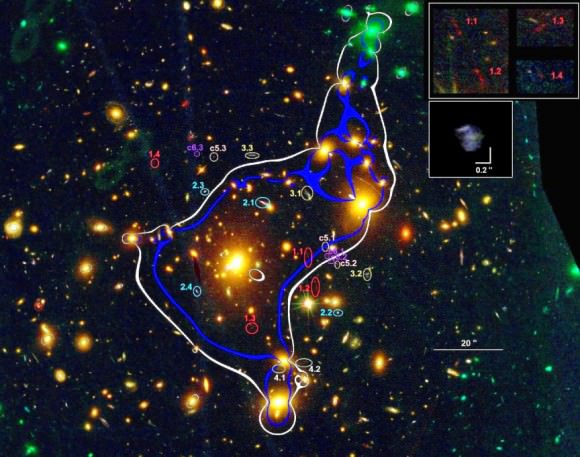
Galaxy Cluster MACS J0329.6-0211 lenses several background galaxies including a distant dwarf galaxy. CREDIT: A. Zitrin, et al.
Gravitational lensing is a powerful tool for astronomers that allows them to explore distant galaxies in far more detail than would otherwise be allowed. Without this technique, galaxies at the edge of the visible universe are little more than tiny blobs of light, but when magnified dozens of times by foreground clusters, astronomers are able to explore the internal structural properties more directly.
Recently, astronomers at the University of Heidelberg discovered a gravitational lensed galaxy that ranked among the most distant ever seen. Although there’s a few that beat this one out in distance, this one is remarkable for being a rare quadruple lens.
The images for this remarkable discovery were taken using the Hubble Space Telescope in August and October of this year, using a total of 16 different colored filters as well as additional data from the Spitzer infrared telescope. The foreground cluster, MACS J0329.6-0211, is some 4.6 billion light years distant. In the above image, the background galaxy has been split into four images, labelled by the red ovals and marked as 1.1 – 1.4. They are enlarged in the upper right.
Assuming that the mass of the foreground cluster is concentrated around the galaxies that were visible, the team attempted to reverse the effects the cluster would have on the distant galaxy, which would reverse the distortions. The restored image, also corrected for redshift, is shown in the lower box in the upper right corner.
After correcting for these distortions, the team estimated that the total mass of the distant galaxy is only a few billion times the mass of the Sun. In comparison, the Large Magellanic Cloud, a dwarf satellite to our own galaxy, is roughly ten billion solar masses. The overall size of the galaxy was determined to be small as well. These conclusions fit well with expectations of galaxies in the early universe which predict that the large galaxies in today’s universe were built from the combination of many smaller galaxies like this one in the distant past.
The galaxy also conforms to expectations regarding the amount of heavy elements which is significantly lower than stars like the Sun. This lack of heavy elements means that there should be little in the way of dust grains. Such dust tends to be a strong block of shorter wavelengths of light such as ultraviolet and blue. Its absence helps give the galaxy its blue tint.
Star formation is also high in the galaxy. The rate at which they predict new stars are being born is somewhat higher than in other galaxies discovered around the same distance, but the presence of brighter clumps in the restored image suggest the galaxy may be undergoing some interactions, driving the formation of new stars.
Source: Universe Today
No hay comentarios:
Publicar un comentario